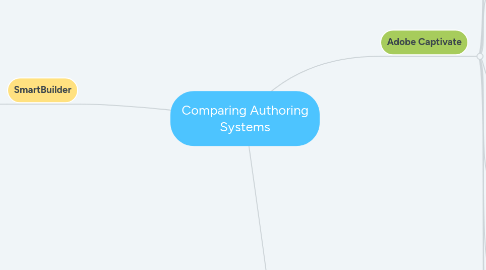
1. SmartBuilder
1.1. Authoring Features
1.1.1. Object-based authoring
1.1.2. Master page - used to create consistent backgrounds
1.1.3. Shared content library
1.1.4. Instant preview of the content
1.1.5. Flow chart
1.1.6. Video and audio integration
1.2. Teaching Features
1.2.1. Scale proportionality - content appears as you intended for learners
1.3. Student Features
1.3.1. Learner response objects
1.3.2. Intuitive user interface
1.4. Assessment
1.4.1. Create standard assessments such as multiple choice, true/false, fill in the blank, or case scenarios
1.4.2. Smart Sets - provide built-in sequencing, scoring, and show/hide logic
1.4.3. Learner response objects such as entry fields, drop-down menus, hotspots, and radio buttons
1.4.4. Percent tracker - shows scores or progress status bar
1.5. Text
1.5.1. Object library includes input text and other text features
1.5.2. Automatic alignment and spacing
1.5.3. Rich text - includes a variety of font, size, color, and style options
1.6. Visuals
1.6.1. Template Catalog or custom templates
1.6.2. Object Library - contains buttons, videos, checkboxes, drop-down menus, images, and more
1.6.3. Graphic effects - add shadows, fades and more
1.6.4. Customize the look and feel of preloaded designed objects or import your own graphics
1.7. Animation
1.7.1. Action panels - combine triggers, conditions, and responses
1.7.2. Transitions - objects can appear, disappear, spin, zoom, fade and more
1.7.3. Animation timeline to add transition effects
1.7.4. Drag and drop objects
1.8. Video
1.8.1. Object library includes videos, audio, timers and more
1.8.2. Embed web enabled resources into lessons from live web sites, documents or media
1.9. Compatibility
1.9.1. Compatible with any SCORM or AICC compliant LMS
1.9.2. Deliver to Web Servers, Offline or Mobile
1.9.3. Convert Third-Party content to SCORM
1.9.4. Import SWF, JPG, PNG, MP3, and FLV formats for media
1.9.5. Import slides from PowerPoint
1.9.6. Embed Wikis, message boards, links to documents or web resources
1.9.7. Flash, Captivate and Camtasia
1.10. Support
1.10.1. Live Support
1.10.2. Free video tutorials
1.11. Costs
1.11.1. Community Edition = Free
1.11.2. Professional Edition - Hosted = $1,970.00
2. Chosen Authoring System
2.1. Adobe Captivate is the authoring system that I chose to create online learning. I chose this system because of its great features. Adobe Captivate provides an intuitive interface that makes the design and development more user friendly and efficient. Its innovative features and responsive e-learning content will allow me to expand my creativity and the opportunity to design and develop an effective and efficient online course. Adobe Captivate has also recently been added to my workplace tools, therefore, since it is a new tool for me, I look forward to learning more about the tool so I can apply what I learn to my work projects.
3. Adobe Captivate
3.1. Authoring Features
3.1.1. Multi-screen responsive e-learning
3.1.2. In-product LMS preview
3.1.3. Master slides - create consistent content
3.1.4. Native app publisher
3.1.5. Best in-class HTML5 publishing
3.1.6. Shared advanced actions to create conditional or multiple actions across projects
3.2. Teaching Features
3.2.1. Smart e-learning design
3.2.2. Responsive projects
3.3. Student Features
3.3.1. Intuitive user interface
3.3.2. Use multiple devices (computer, tablet or mobile)
3.4. Assessments
3.4.1. Comprehensive quizzing
3.4.2. Knowledge check questions can be embedded in the course
3.4.3. Remediation workflow is used to improve percentage of successful outcomes
3.5. Texts
3.5.1. Responsive text allows paragraphs to automatically collapse into a few lines and learner click to view more
3.5.2. Text to speech
3.6. Visuals
3.6.1. Asset store includes over 75K free learning images, themes, games, and scenarios
3.6.2. Responsive themes include numerous backgrounds, styles, fonts, and layouts
3.6.3. Supports Scalable Vector Graphics (SVG)
3.6.4. Roundtripping with Adobe Creative Cloud, Adobe Photoshop, Illustrator and Audition
3.7. Animations
3.7.1. Responsive motion effects without programming such as motion paths, transitions and rotations
3.7.2. Responsive drag and drop interactions
3.7.3. Multi-state objects such as triggers, built-in states, smart shapes, images, texts, buttons and more
3.8. Video
3.8.1. Screen capture software to capture simulations with single recording sessions; capture on-screen actions, mouse movements, system audio, and keyboard activity
3.8.2. Audio-video support and synchronization
3.8.3. iOS device capture
3.9. Compatibility
3.9.1. Publish with other Learning Management Systems
3.9.2. Import PowerPoint slides
3.9.3. Compatible with any SCORM or AICC compliant LMS
3.10. Support
3.10.1. Accessibility Support (Section 508 and Web Content Accessibility Guidelines 2.0)
3.10.2. Online video tutorials, articles and User Guide
3.11. Costs
3.11.1. Subscription = $29.99 per month
3.11.2. Full License = $1,099.00
3.11.3. Student and Teacher Edition = $349.00
3.11.4. Upgrade Price = $449.00

